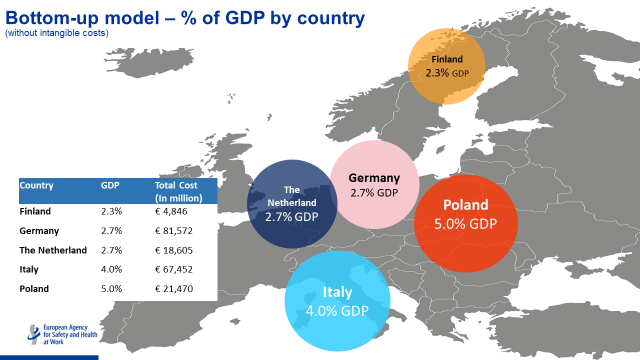Is it really possible to make a profit by investing in occupational safety? In these challenging times, the focus in most companies is on results and the strategy towards this is often just cost cutting. Where possible, they postpone certain investments. Certainly safety-related plans drop down the priority list and sometimes they even just stay there.
What if we told you that investing in safety does not cost money, but that it even makes money... OHS is good for business! A sales pitch for prevention advisers, you think? Read on to find out how heavy the costs are, but also how big the return on investment really is. Or: how does consistently choosing safety actually lead to profit?
Reliable calculation
In order to paint the whole picture, it helps to gain insight into what it costs when you do not opt for safety.
For this we refer to an extremely fascinating but also lengthy study by the European Agency for Health and Safety at Work.
First of all, a system was sought to arrive at reliable cost estimates on the basis of the available data. Both the bottom-up* and top-down* models allow an accurate price to be put on work-related accidents, deaths and occupational illnesses. That price is actually the sum of several types of costs, some borne by the insurer and some directly by the employer.
* bottom-up model: takes into account direct costs, indirect costs and intangible costs (effects on quality of life and health);
* top-down model based on the monetary value of work-related DALY.
Types of costs
Depending on the model, they are classified slightly differently, but the list of direct, indirect and intangible costs is quite long. The largest of these are the immediate costs of primary health care, the loss of productivity, reduced output, absenteeism, rehabilitation, reintegration, presenteeism (returning to work too early and not yet productive), early retirement and increased insurance premiums.
In addition, there are the "intangible" costs, expressed in the so-called "burden estimate" or impact on the victim's well-being. The DALYs (Disability Adjusted Life Years) stick an amount on the loss of quality years of life.
Facts and figures
Thus, the individual worker, the company and the social security system all lose out when occupational safety is neglected. This graph shows how all these costs weigh on the GNP of the countries involved in the study.

It can also be different
Several case studies show that companies with higher standards of health and safety policy are more sustainable and successful. In no fewer than 11 of the 13 cases did the measures provide a positive return on investment within five years. In fact, the broader the measures for occupational safety and health, the more profitable. So choose broad measures rather than tackling a specific problem. Moreover, when workers were involved in the new choices, the positive effect was even stronger.
The ISSA (International Social Security Association) has also calculated that each euro invested in good occupational safety and health is estimated to yield 2.2 euros. Obviously, this is also beneficial for the balance of the entire social security system.
At company level, this is where the biggest gains lie:
- less loss of key employees;
- more motivated employees;
- higher productivity;
- up to half (!) less sick leave due to fewer accidents, incidents and health problems;
- fewer business interruptions;
- better conditions with insurers;
- fewer claims;
- easier to win and retain contracts, because business customers also benefit from a strong HSE policy.
Proven beyond doubt
If you are looking for more evidence, you will find many more success stories after a round of googling.
However, at Seekurico we also regularly notice that it is not easy for every company to make the groundwork. Especially in small and medium-sized companies, there is sometimes a lack of support or time for a thorough analysis of the starting situation. And what next? If the safety policy has been a low priority for some time, it is usually even more a case of not seeing the wood for the trees. That is exactly what we are specialised in.
More and more companies are taking this route. Do not hesitate to let us take a look. We quickly assess where growth is needed and possible. Always in confidence and involved from day one. We guide your company at your pace, on the way to your own successful measures for work safety and increased profits.


